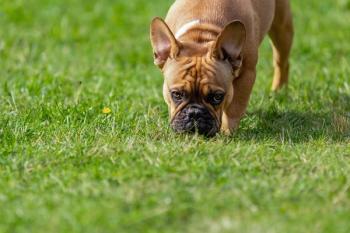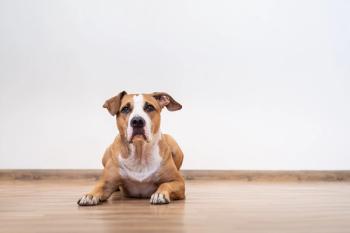
Standard and novel diagnostic approaches to patients with respiratory disease (Proceedings)
Diagnostic tests are obviously required to confirm the presence of many respiratory diseases in small animals. However, respiratory medicine is an underdeveloped subspecialty in veterinary medicine, and there are relatively few sophisticated tests that are available to the clinician that actually diagnose specific pulmonary disorders.
Diagnostic tests are obviously required to confirm the presence of many respiratory diseases in small animals. However, respiratory medicine is an underdeveloped subspecialty in veterinary medicine, and there are relatively few sophisticated tests that are available to the clinician that actually diagnose specific pulmonary disorders. Instead, most of the commonly available tests are best used to point us in the right direction, and to rule out the presence of other potentially confounding disorders. So for example, when an older patient has a new-onset cough, an abnormal chest radiograph can point us toward a diagnosis of pulmonary malignancy, heart failure, while a normal chest radiograph may suggest a diagnosis of a non-serious nature.
This manuscript will review the diagnostic tests that are available to evaluate small animals with signs of respiratory disease, including the advantages, disadvantages and current controversies regarding many of these tests used to evaluate pets with signs of pulmonary impairment.
History
Accurate history taking is probably the single most important diagnostic test the clinician can perform in veterinary pulmonology.
Age, breed and sex
The signalment frequently yields important clues regarding the patient's condition. For example, sneezing and nasal discharge in a kitten suggests a viral etiology, while the identical signs in an aged cat suggest a more malignant process. Pulmonary neoplastic processes tend to occur in older animals, while mediastinal masses and nasopharyngeal polyps are commonly diagnosed in both young and middle aged cats. Particular breeds tend to have increased rates of certain respiratory disease, including asthma in Siamese breed felines.
Present environment and geographic origin
I always ask clients if there are smokers in the house, if they have recently cleaned their fireplace, if they have changed carpeting or if their house has undergone significant renovation in the last 6 months. I also ask every owner about recent travel history to determine if their pet is at increased risk for "geographically specific" diseases such as mycotic infection, heartworm or aelurostrongylus infestation.
Present complaint
Sick animals often hide, or shrink away from frequent contact with the owner. The feline species is of course famous for disappearing for long stretches of time, especially if the cat is an "outdoor" pet. Clients often believe that their pet has "suddenly" stopped eating or playing when the disorder causing these signs has developed over a much longer period of time. This is an important consideration when evaluating a complaint related to the respiratory system. For example, sneezing and nasal discharge may be obvious to most clients, whereas increased inspiratory efforts and nasal flaring due to a slowly developing pleural effusion may be invisible to the owner. So, if we ask our clients "how long has fluffy been ill?" they may tell us "He just started coughing" and we may miss important information. Instead, if we ask clients "when the last time fluffy was was normal?" they may reply "He really hasn't seemed the same for about a month, but I was out of town a lot and I haven't really seen him that much until this weekend."
Additionally, it is important to determine 1) the duration of signs, 2) whether clinical signs are static or evolving, 3) if the patient has ever exhibited the presenting signs before, 4) if treatment was initiated in the past, and 5) the success or failure of such treatment.
Physical examination
The physical state of the patient and the good judgment of the veterinarian will determine how thorough and for how long we perform a physical exam. Experienced clinicians know that the cat with open-mouthed breathing is not a candidate for a leisurely, prolonged physical examination. However, a sneezing but otherwise seemingly healthy animal should have a comprehensive examination during which all organ systems are thoroughly evaluated.
The most important part of the physical examination of the respiratory system is inspection, to determine whether the respiratory difficulty can be identified primarily during inspiration or during expiration. If this isn't obvious during the exam, more subtle clues in evaluating abnormal breathing patterns include inspection of the nares for "flaring", or abduction of the legs to increase the size of the thoracic cage. Even in situations in which the animal is in obvious respiratory distress, I rely upon the finding of inspiratory vs. expiratory difficulty to guide emergency interventions. Specifically, animals with noisy breathing during inspiration (stridor) or inspiratory difficulty most commonly have either upper airway obstruction or disease within the pleural space, including effusion, pneumothorax or mediastinal mass. Animals with labored breathing during expiration most commonly suffer from chronic bronchitis or asthma. Therefore, if a dog or cat has an increase in inspiratory respiratory effort without stridor, you can make a presumptive diagnosis of pleural space disease, followed by thoracocentesis. Similarly, a cat with an expiratory wheeze probably has bronchial obstruction, and should be treated for presumed bronchospasm even before the underlying cause is determined. It is important to emphasize that these quick assessments are often important in the initial phase of emergency care. However, they are not a substitute for more thorough evaluations that can occur after emergency interventions have been initiated.
Animals with panting or open mouthed breathing are not so easily classified, and may suffer from congestive heart failure, pneumonia, pulmonary embolism or neoplasia, although clearly, patients may present in distress in the later stage of any respiratory disorder. The veterinarian should also keep in mind that other, non-pulmonary causes of abnormal ventilatory patterns are common and may mimic signs of respiratory disease.
Palpation
The feline thoracic cage is usually very compliant, and resistance to compression suggests the presence of a space-occupying lesion such as mediastinal mass or diaphragmatic hernia with displacement of abdominal contents into the chest cavity. Additionally, the maximal cardiac beat (point of maximal impulse, PMI) is normally felt at the border of the left elbow, if you feel it more caudally there may be left ventricular enlargement. If the PMI is on the right side, there may be a mediastinal shift due to atelectasis. Chest palpation is also the first chance to detect cardiac arrhythmias. Both inspection and palpation of the nasal planum and frontal bones may reveal asymmetry or enlargement, suggestive of bony distortion from neoplasia or mycotic infection.
Thoracic percussion
In the authors' experience, percussion is not a helpful tool in the physical examination of most small animals, primarily because the chest is so small compared to human beings and large animals (cows, horses).
Auscultation
Auscultation is a classic method of examining the patient with signs of respiratory disease. The terms crackle and wheeze have replaced the older terms rale and rhonchi to describe these adventitious sounds. I don't rely upon information gained by chest auscultation to make diagnoses of respiratory disease in small animals. Physicians always ask their human patients to breathe deeply with an open mouth, and this increases the quality and quantity of respiratory sounds. We can't do that successfully with our patients, and the amount of air moving in and out of a resting animal is often not enough to produce audible sounds of diagnostic significance. Occasionally, by using the tip of one finger to occlude a nostril for four or five breaths, when you release the obstruction the pet will take a big breath in (and out) and this may augment breath sounds that were previously inaudible. When adventitious sounds are appreciated, there is usually significant respiratory pathology that can be recognized by other methods including inspection and palpation. In summary, thoracic auscultation is a valuable diagnostic tool to confirm the presence of respiratory pathology. It is not as important a diagnostic tool as it is in human medicine, and the absence of abnormal respiratory sounds does not imply absence of respiratory disease.
Evaluation of the nasopharynx and larynx
Signs of nasopharyngeal and laryngeal disease include coughing, gagging, choking, sneezing, snorting, epistaxis, nasal discharge, stridor, "voice" change and facial deformity. Diagnostic techniques which are frequently used alone, or in conjunction with other tests to determine the cause(s) of these signs include, nasopharyngeal culture, cytology, biopsy, and direct visualization.
Culture
Culture of the nasal cavity is rarely indicated for chronic sneeze, epistaxis, and/or nasal discharge. Small animals have a wide range of normal intranasal commensal bacterial flora, most notably Staph, Strep, E coli, Pasteurella and Bordetella. Therefore, bacterial culture of the nares is an unreliable tool in diagnosing the etiology of rhinitis.
Cytology
Cytological evaluation of cells within the nasal cavity may be indicated when there is a history of chronic sneeze, nasal discharge or epistaxis, the same indications that may be present for nasal culture. Neutrophils and other inflammatory cells may predominate in disorders caused by many different etiologies including foreign body, trauma, neoplasia, and infection. In general, the interpretation and cytological evaluation of material obtained by nasal swab is most likely to result in a reliable diagnosis if fungal organisms or malignant cells are recovered.
Nasal biopsy
Indications for nasal biopsy include gross facial deformity, or radiographic evidence of destruction or deviation of the intranasal structures, or loss of trabecular detail. The author strongly suggests visualized and guided biopsy during rhinoscopy. To perform this technique, a 3 mm rhinoscope is used to visualize the suspected area of disease, and a flexible biopsy instrument is passed through the biopsy port of the endoscope. The biopsy cup can be visualized in the nasal cavity and multiple tissue samples can be obtained.
Naso/pharyngo/laryngoscopy
Nasopharyngoscopy should be considered to evaluate signs of gagging, chronic sneezing, epistaxis, nasal discharge unresponsive to standard therapy, nasofacial deformity, change in meow or purr or bark and noisy breathing. Direct visualization of the lumen of the nares may be accomplished using an otoscope cone (distal aspect only) or rigid fiberoptic scope (1.7-3.3 mm outer diameter), and as described above for nasal biopsy. Small animals with the symptom of gagging or forced swallowing may have a pharyngeal polyp, or less commonly a foreign body such as a blade of grass dorsal to the soft palate. A non-traumatic forceps or hooked dental instrument can be used to retract the soft palate, and a dental mirror is placed within the posterior pharynx to visualize the area dorsal to the soft palate. However, a flexible fiberoptic scope retroflexed 180° is the most appropriate instrument to visualize this area.
Small animals with stridor or voice change should have laryngoscopy performed to determine if laryngeal dysfunction, including laryngeal neoplasia is present. To perform laryngoscopy, the animal should be lightly anesthetized. A laryngoscope blade or tongue depressor can be used to depress the epiglottis, and a pen light can be used to visualize the area. A diagnosis of laryngeal paresis or paralysis is reasonable if either or both laryngeal folds fail to abduct during normal breathing. It is important not to depress the epiglottis too forcefully, or tilt the head up at an acute angle, because normal laryngeal architecture can be artificially altered, resulting in an inappropriate diagnosis of laryngeal disease. When in doubt, it is appropriate to use Dopram, 1mg/kg i.v. to induce increased rate and depth of respiration. In this way you may avoid the confounding issue of anesthesia-induced respiratory depression that might reduce the normal movement of the vocal folds and associated cartilage.
Evaluation of the tracheobronchial tree
Signs of tracheobronchial disease include cough, gag, inspiratory (extrathoracic trachea) or expiratory (intrathoracic airway) dyspnea, and exercise intolerance. The following diagnostic tests may be performed alone or in combination to determine the cause of these signs:
Culture
General Comments: Most small animals with chronic signs of cough, gag or expiratory difficulty that are otherwise systemically well do not have clinically significant respiratory infections. Nevertheless, bacteria may be found in material obtained from the tracheobronchial tree of these patients. This apparent paradox is easily explained, the tracheobronchial tree is not routinely sterile.
As in almost all situations in clinical medicine, the culture results obtained from any of the methods described below should be interpreted in light of the patient's clinical history, physical signs, and other diagnostic test results.
Trans tracheal wash (TTW) is a time honored method of obtaining uncontaminated material from the airway for culture (to bypass the oropharyngeal flora). This technique was first described for use in conscious human patients, and is a suitable technique for medium to large sized dogs. Better methods than TTW exist for retrieval of airway material for culture (see below) and the author does not advocate the TTW technique in cats. If alternative methods are not feasible, TTW can be safely performed in small animals by placing a long dwelling 23 g catheter through the crycothyroid membrane to the level of the thoracic inlet, followed by injection of 0.5 cc/kg body weight of non-bacteriostatic saline (previously warmed to 37° C). Placement of the animals head and thorax in a dependent position makes it easier to retrieve the instilled fluid. Alternatively, a sterile endotracheal tube may be passed and used as the conduit for the flush solution.
Use of the guarded microbiology brush (Microvasive, Milford Mass) is an alternative to the TTW that is a reliable method of retrieving airway material for culture. The brush is designed to be passed through the biopsy port (2 mm diameter) of a previously positioned adult (5.0 mm outer diameter) bronchoscope. If a bronchoscope is not available the brush may be passed through a sterile endotracheal tube that has been previously placed in the anesthetized patient. The distance from the mouth to the thoracic inlet should be measured. The brush can then be passed this distance, or until any resistance is felt. The inside brush can then be extruded, gently massaged within the airways, and resheathed. Finally, the brush can be withdrawn from the bronchoscope and processed by cutting off the end of the brush into a sterile red top tube, with 0.25-0.5 ml non-bacteriostatic sterile water to prevent the brush from drying out.
Secretions obtained using this brush may be cultured routinely or in a quantitative fashion. Quantitative bacterial cultures have been used to distinguish colonization from infection in human beings with pneumonia. In these cases, bacterial growth at a concentration of less than 104 CFU/ml is believed to represent non pathologic colonization and antibiotic therapy is not recommended. Healthy small animals may harbor an aerobic bacterial population within their main stem bronchi at a concentration of as high as 103 CFU/ml.
Cytology
General comments: Cytological evaluation of respiratory secretions obtained from small animals with signs of tracheobronchial disease is most helpful to confirm suspected infectious organisms and exfoliated neoplastic cells. Cytology is less helpful to diagnose the cause of non-infectious inflammation of the lower airway. This is because the macrophage and the eosinophil are cells that might reflect inflammation in other body fluids, but is a normal inhabitant of the feline lower airway. Additionally, total cell counts are not routinely determined from airway fluids.
In general, large numbers of neutrophils (more than occasional) supports the finding of chronic bronchitis in small animals, while overwhelming populations of eosinophils (>75 %) are consistent with the diagnosis of asthma.
Trans tracheal wash
The TTW technique has significant limitations. For example, the volume recovered from TTW is widely variable. When small volumes are recovered, cells that adhere to mucus are generally studied in greatest detail. Importantly, these cells may or may not reflect the general nature of airway inflammation; the interpretation of the significance of these cells should be made with great caution. This is of sufficient concern that, in the author's opinion, interpretation of cells recovered using the technique of TTW should be limited to the diagnosis of infectious or neoplastic disease. Even in clinical situations when infectious or neoplastic disease is suspected, there are better ways to obtain tracheobronchial secretions for cytological evaluation (see below).
Bronchoalveolar lavage
General Comments: As previously mentioned, a major limitation in the cytological interpretation of tracheobronchial secretions is the lack of uniformity in the collection, processing and reporting of the samples. Unlike analysis of other body fluids such as whole blood, urine, spinal or joint fluid, total and differential cell counts from tracheobronchial washings are not routinely determined. This is due to, in part, the various methods used to collect and analyze the samples and the lack of uniform results that are obtained. The technique of bronchoalveolar lavage (BAL) was developed to better standardize the collection, analysis and reporting of bronchial and alveolar lining cells and secretions.
To insure the maximal return of fluid, BAL should be performed through a FB "wedged" into a segmental or sub segmental branch of a lung lobe. Using this technique, relatively large volumes of fluid (2 cc/kg of body weight) can be repeatedly instilled and recovered with confidence. If a bronchoscope is not available, a modified BAL may be performed by attaching a syringe adapter to the end of an endotracheal tube and instilling saline (5 cc/kg body weight). Total cell counts in excess of 1000/μl recovered from BAL fluid obtained using either technique may be of value in distinguishing clinically healthy small animals with large numbers of eosinophils within their airway washings from small animals with alveolitis, asthma or heartworm infestation.
To prevent the development of hypoxemia during BAL, pre and post administration of 100% oxygen for a minimum of 10 minutes is necessary. Because of the potential loss of large volumes of fluid within the lung only persons experienced in this technique should perform BAL in small animals.
Tracheobronchoscopy
Tracheobronchoscopy is indicated for animals with chronic cough or gag unresponsive to standard therapy, and for small animals with radiographic evidence of lung infiltrates or consolidation without clinical signs of pneumonia. This technique is also valuable to visualize masses within the trachea and main stem bronchi and to assess the structural integrity of the tracheobronchial tree. Additionally, abnormal mucus secretion, collapsing airways and mucosal appearance can be seen. Tracheobronchoscopy can be performed with either a rigid or a flexible fiberoptic bronchoscope (FB). The rigid bronchoscope is usually less costly to purchase than a FB and requires little formal training to use. Additionally, the rigid scope is easily passed through an endotracheal tube adapter (Bodai Swivel "Y", Sontek Medical, Dallas TX.) so that gas anesthesia and oxygen may be administered during the procedure. In general, rigid scopes deliver a better visual image than FB's, although the image seen through a FB is certainly adequate for any diagnostic study. In practice, FB's are much more clinically useful. The adult sized FB (5 mm outer diameter) has a 2.0 mm channel that is wide enough to allow passage of biopsy, retrieval and culture instruments. It is very important to recognize that these FB's occlude > 50% of the airway of small animals, these studies should be performed only by persons very familiar with their use. Pediatric sized FB (3.5 mm outer diameter) can be passed through a 4.5 FR endotracheal tube and cause less airway obstruction. Because these FB are smaller the operator can visualize smaller airway branches. The disadvantage of the pediatric FB is the smaller biopsy channel (1.3 mm) which permits only lavage.
Malignancies of the larynx, trachea and bronchi are uncommon but recognized conditions in small animals. Laryngeal masses may be visualized directly using techniques previously recommended to assess laryngeal function. Masses within the lumen of the tracheobronchial tree can be visualized using a rigid or flexible bronchoscope. If abnormal growth is suspected and visualized, biopsy is indicated. This may be easily accomplished using a standard biopsy instrument passed through the biopsy channel of the flexible FB.
Pulmonary function tests
General Comments: Pulmonary function testing is commonly performed in persons to obtain objective measurements of the amount of respiratory disability present, to recognize the presence of early disease, and to monitor response to therapy. In general, pulmonary function tests require sophisticated equipment and patient cooperation. Clearly this is a limiting factor when attempting to apply these techniques to veterinary patients. Nevertheless, a number of tests to determine pulmonary function in dogs and small animals are now available.
Arterial blood gas analysis
Perhaps the most straightforward and accessible pulmonary function test in veterinary pulmonary medicine is measurement of arterial blood gas (ABG). This examination generally requires 0.3 ml or less of arterial blood. Arterial samples are most practically obtained using a 1 cc syringe and 25 g needle to pierce the femoral artery. Arterial blood samples are obtained differently from venous samples, in that the vessel is felt rather than directly seen, and because the needle may be intentionally passed through both sides of the arterial wall and then slowly withdrawn until the needle is within the lumen of the artery.
Arterial blood gas analysis is valuable in determining the extent of respiratory impairment in most veterinary patients. For example, hypoxemia is the most common finding in small animals with chronic respiratory disease, and the practitioner can assume a direct correlation between changes in the partial pressure of oxygen and the clinical status of the. This parameter should also be evaluated over time to determine the efficacy of therapy. Additionally, ABG analysis will often yield clues regarding the etiology of the disease process. For example, hypoventilation is always characterized by an increase in arterial CO2. Therefore, measurement of ABG's can confirm or exclude hypoventilation as the cause of respiratory difficulty during anesthesia. Additionally, estimates of the metabolic component of the acid base status may be important in cases of diabetes mellitus, renal insufficiency or shock. Without arterial blood to evaluate, the practitioner should consider that the CO2 content of venous blood, which is commonly reported on routine biochemistry "panels", is predictably within one unit of the amount of bicarbonate within arterial blood.
Tests of airway reactivity are performed in human medicine most commonly to assist in diagnosis of bronchial asthma, although patients with other bronchopulmonary disorders including chronic bronchitis may have increased airway reactivity. Patients are required to maximally inhale and then exhale forcefully. Air volume during the first second of exhalation is measured before and after inhalation of increasing concentrations of nebulized methacholine. Normal individuals generally lose about 20% of expiratory volume within the first second of forced expiration (FEV1) after inhaling an 8% solution of methacholine. In contrast, patients with asthma may have significant decreases in FEV1 after inhalation of very low concentrations of methacholine (<1%).
Within the last few years a new technology has been developed that allows us to measure bronchoconstriction (at rest and in response to nebulize methacholine) in awake, unrestrained small animals. The "Buxco Box" is a clear Plexiglas chamber about the size of a home fish tank that is instrumented to measure relative lung resistance in small animals on a breath-by-breath basis. Methacholine can be nebulized into the box to measure airway reactivity. Important uses of this test may be to distinguish small animals with chronic bronchitis from small animals with asthma, and to better assess the patient's response to, and need for, anti-inflammatory and/or bronchodilator therapy.
Conclusions
Diseases of the small animal respiratory system present a unique diagnosis challenge to the veterinary practitioner. First, veterinary pulmonary medicine is not a subspecialty in veterinary medicine, and there are very few veterinarians who are academically trained in this discipline. Second, the size of cats and small dogs presents a barrier to most invasive procedures. Third, there is a relative absence of pulmonary function tests that are available in private practice. Nevertheless, new diagnostic techniques are rapidly being developed to evaluate small animals with signs of respiratory disease. Clinicians should not be discouraged, but instead should use the available diagnostic tests as all tests should be used, with knowledge of their advantages, disadvantages and limitations.
Newsletter
From exam room tips to practice management insights, get trusted veterinary news delivered straight to your inbox—subscribe to dvm360.





